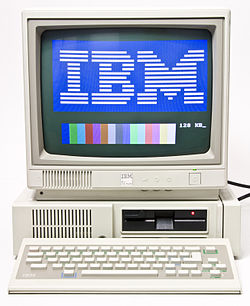The IBM PC-JR and PC-AT
The IBM Personal Computer AT and JR were Personal Computers commercialized from 1984 to 1987.


Even if in the same era, those 2 Personal Computers had 2 different feedbacks from the market: while the PC-Jr was almost considered a fail for the IBM, the PC-AT (Personal Computer - Advanced Technology) deeply innovated the computer architectures.
| Properties / Models | IBM PC Jr | IBM PC AT |
| CPU (MHz) | 4.77 | 6 or 8 (See Graph ) |
| RAM (kB) | 64 or 128 (up to 736) | 256 or 512 (up to 16 MB) |
| Price ($) | 1300 | 4000-6700 |
| Presentation Date | 1st November 1983 | 1984 |
| Graphic Card | CGA | EGA |
The PC-Jr had different I/O devices which could work with: cassettes, optic pens, RGB and Composite
port, wired or wireless infrared 62-keys keyboard, mouse, speakers, a serial port and for gamers: it was out with 2 joystick ports!
It could read floppy disks, had a 300 bps modem and was one of the first models which could use VGA, the universal standard
before the HDMI standard.
More devices was produced by third party manufacturers, The PC-Jr could use most of them.
As usual, the bigger resolution the user wanted, the less colours he could use:
with a resolution of 640x200 the colours available were 2 or 4, with a 320x200 or 160x100 resolution 4 o 16 colours could be displayed.
Remembering that we're in the end of 1983, the commercial can helps us to understand how many softwares could be installed on the PC-JR.
External Links
- [visited on 1/11/2014] Wikipedia - IBM PC-JR
- [visited on 1/11/2014] Wikipedia - IBM PC-AT